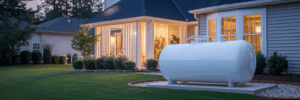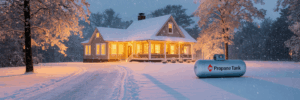
Millions of American households rely on propane for the simple comforts of home, from a warm furnace on a cold morning to a hot shower at the end of the day. This reliability, however, is not automatic. Propane’s excellent safety record is the direct result of proper care and attention. Understanding how to maintain a propane tank is the first step toward ensuring your system operates as it should.
Viewing maintenance as a fundamental practice for home safety and efficiency, rather than a burden, is key. Neglecting your tank can lead to safety risks, poor appliance performance, and unexpected costs down the line. Fortunately, most issues arise from a handful of common and entirely preventable mistakes. Let’s explore what they are and how you can avoid them.
Mistake 1: Skipping Regular Visual Inspections
Your first line of defense against common propane tank problems is your own set of eyes. A routine visual check can help you spot trouble long before it becomes a serious issue. This isn’t about tinkering with the tank; it’s about being an informed observer. During your residential propane tank inspection, you should look for specific signs of wear and tear.
Pay close attention to the tank’s surface. While a little surface rust might be cosmetic, you should be concerned about significant rust that is causing the paint to flake or the metal to pit. Also, look for noticeable dents or deep scratches. Another critical check is the tank’s stability. It must rest on a solid, level base, like a concrete pad, to prevent moisture from the ground from accelerating corrosion. If your tank is tilted or sitting directly on the soil, it needs professional attention.
The most important takeaway is that this is for assessment only. If you spot any of these issues, your only job is to call your propane supplier for a professional evaluation. Never attempt to make repairs yourself.
| Area to Check | What to Look For | Action to Take |
|---|---|---|
| Tank Surface | Deep rust, flaking paint, dents, or gouges | Call your propane supplier for assessment. |
| Tank Foundation | Tank is tilted, unstable, or sitting directly on soil | Contact a professional to level the tank. |
| Valves & Fittings | Visible debris, ice buildup, or physical damage | Do not touch. Report to your supplier. |
| Surrounding Area | Overgrown vegetation, flammable debris, or stored items nearby | Clear a 10-foot radius around the tank. |
Mistake 2: Overfilling the Tank
It might seem counterintuitive, but a propane tank should never be filled to 100% capacity. This is because of a simple scientific principle: liquid propane expands as its temperature rises. That extra 20% of empty space, known as vapor space, is a critical safety feature designed to accommodate this expansion. Ignoring this “80% fill rule” introduces serious propane tank overfilling dangers.
If a tank is too full, rising pressure can force the pressure relief valve to open. Instead of releasing harmless vapor, the valve might discharge liquid propane, which can create a dense, flammable cloud near the ground and pose a significant fire hazard. While modern tanks are equipped with an Overfill Prevention Device (OPD), this is a backup safety measure, not a substitute for correct filling procedures.
This is why refilling a propane tank is a job strictly for trained professionals. Always rely on a reputable supplier for your residential propane needs. Be wary of any service that suggests filling your tank completely; it’s a clear sign they are not following essential safety protocols.
Mistake 3: Ignoring Potential Signs of a Leak
A propane leak is an emergency that requires immediate action. The most recognizable sign is the distinct “rotten egg” smell, an odorant called ethyl mercaptan that is added to propane specifically to make leaks detectable. However, you should also be aware of other, more subtle indicators.
Listen for a hissing or whistling sound near the tank or gas lines. Visually, you might see bubbles on wet or frosted areas of the tank’s surface or notice a patch of dead vegetation in the grass nearby. You can perform a simple propane tank leak test by applying a solution of soap and water to the connections and fittings. If you see bubbles forming, gas is escaping. As the Propane Education & Research Council outlines in its guide on what to do if you smell gas, your response must be swift.
If you suspect a leak:
- Do not use phones, light switches, or anything that could create a spark.
- Extinguish all open flames immediately.
- Leave the area right away.
- From a safe distance, call your propane supplier’s emergency line or 911.
A suspected leak should always be treated with the utmost seriousness. For more detailed guidance, review the propane safety protocols we follow to protect our customers.
Mistake 4: Neglecting Regulators and Valves
While visual checks are important, some components require a professional’s touch. The regulator is a perfect example. Think of it as the brain of your propane system; its job is to reduce the high pressure inside the tank to a safe, usable level for your home’s appliances. When a regulator starts to fail, it can affect both safety and performance.
Signs of a faulty regulator include:
- Yellow or sooty flames on your stove burners instead of blue ones.
- Popping noises when you turn an appliance on or off.
- Flames that are either too low or too high.
Regulators typically have a lifespan of 10 to 15 years and are not designed to last forever. It is critical to understand that adjusting, repairing, or replacing regulators and valves is not a DIY task. These are precision components that, if handled incorrectly, can create dangerous pressure problems. Professional service includes testing pressures and inspecting all our high-quality equipment to ensure your system runs safely and efficiently.
Mistake 5: Storing and Placing Tanks Improperly
Proper placement is one of the most fundamental propane tank safety tips, but the rules differ for small, portable cylinders and large, stationary tanks. For the portable tanks used with grills or patio heaters, the rules are simple but non-negotiable. They must always be stored:
- Outdoors, never in a garage, shed, or basement.
- Upright on a stable, level surface.
- Away from any sources of ignition.
Storing a cylinder indoors is forbidden because a small leak could allow flammable gas to accumulate in an enclosed space.
For large residential tanks, the requirements are more specific. As mentioned earlier, they need a solid, level foundation. They also must adhere to strict clearance rules, typically maintaining at least 10 feet of distance from ignition sources like air conditioning units, open vents, and property lines to comply with local fire codes. It is also essential to keep the area around the tank clear of flammable materials, such as dry leaves, overgrown bushes, or stored wood.
Choosing a Professional Partner for Peace of Mind
Ultimately, propane safety is a partnership. While your vigilance in performing visual checks and recognizing warning signs is vital, the expertise of a qualified propane supplier is indispensable. When selecting a provider, look for a company with certified technicians, a transparent commitment to safety, and a reliable 24/7 emergency response service.
Think of professional inspections and maintenance not as an expense, but as a crucial investment in your family’s security and your home’s operational health. This proactive approach, combined with a trusted professional partnership, is the surest way to enjoy the many benefits of propane with complete confidence. If you have any questions or need to schedule a service, please contact us. Our team is here to help.
About Jennifer Whitaker
Propane industry expert and content contributor for MyPropane.com.
View all posts by Jennifer Whitaker →Related Articles

Five Propane Tank Mistakes That Risk Your Home's Safety
Oct 29, 2025 • 8 min read
Discover simple, effective ways to maintain your propane system and prevent hazardous situations with our straightforward advice.

Your Essential Guide to Winter Propane Prep
Oct 22, 2025 • 7 min read
Follow these essential steps to ensure your propane system is safe, efficient, and reliable all winter long.

